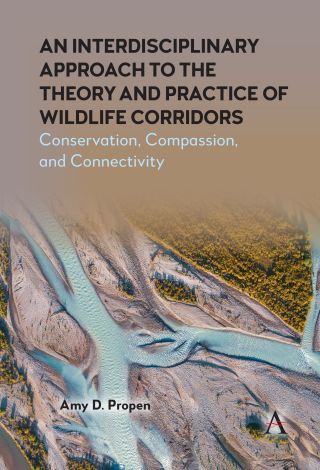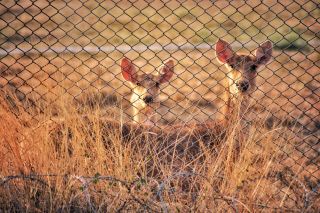Animal Behavior
Wildlife Corridors: Conservation, Compassion, and Freedom
Compassionate conservation combines connectivity, empathy, and ecology.
Posted June 10, 2024 Reviewed by Hara Estroff Marano
Key points
- A new book helps expand our understanding of our relationships with wildlife.
- All spaces are interconnected and we need to live symbiotically with coexistence in mind.
- Setting up aerial corridors in urban environments mitigates light pollution and helps migratory birds.
- Protecting ecosystems and species has benefits for humans as well as other animals.

In today's increasingly human-dominated world, nonhuman animals (animals) need all the help they can get. They deserve safe areas in which to travel about, and human-free corridors are the least we can do for them to have better lives and to enjoy the freedoms such areas offer.
In her latest book, An Interdisciplinary Approach to the Theory and Practice of Wildlife Corridors: Conservation, Compassion and Connectivity, Dr. Amy Propen who teaches writing at the University of California, Santa Barbara, carefully explains why providing corridors is the compassionate and empathic thing to do and why we must do all we can to offer these "luxuries" to other animals as we wantonly trespass into their homes.
Marc Bekoff: Why did you write An Interdisciplinary Approach to the Theory and Practice of Wildlife Corridors?
Amy Propen: Ultimately, I wrote this book to help expand our understanding of our relationships with wildlife. More specifically, I wanted to describe the power of wildlife corridors to foster coexistence, to reconnect ecosystems, and to help wildlife move through areas impacted by human development. That is, we can no longer perceive national parks and protected spaces as intended only for wildlife, just as we can no longer perceive urban spaces as intended only for people. All of these spaces are interconnected, and we need to design and build with coexistence in mind; in short, we need to do a better job of living symbiotically with nature.
MB: How does your latest book relate to your background and general areas of interest?
AP: I have a background in geography and environmental studies, as well as in professional communication. A lot of my writing blends these two areas together, because I think it’s important to communicate clearly about environmental issues, especially in ways that can speak to a range of audiences and reach anyone who wants to help foster coexistence in the world.
MB: Who do you hope to reach in your book?
I’m hoping this book can be useful to anyone who wants to learn about coexisting with our nonhuman kin in an age of ever-increasing human development.
MB: What are some of the major topics you consider?

AP: The book first describes wildlife corridors in the more traditional sense—as infrastructures and sections of habitat that are large enough to provide animals with a bridge between larger blocks of habitat, which can then help re-establish or protect biodiversity. I then extend this idea to argue that, if designed with the principles of compassion and empathy in mind, and if efforts are made to incorporate the voices of multiple stakeholders, including Indigenous knowledges, then wildlife corridors have greater potential to perform conservation practice grounded in an ethic of care and empathy.
The first part of the book addresses key concepts related to wildlife corridors, including connectivity, biodiversity, scale, types of corridors, green infrastructure, and habitat fragmentation. I discuss the design and management of wildlife corridors, and then explore the perspectives that I suggest should inform connectivity projects, including compassionate conservation, empathy, and ideas about traditional ecological knowledge.
Traditional ecological knowledge refers to a set of practices and beliefs that are often handed down through generations by cultural transmission and focus on the relationship of all living beings with each other and their environment. Traditional Indigenous philosophy is based on the idea that a deep respect for nature should inform all activities related to the natural world, and I’m suggesting that such philosophies should inform wildlife corridor work whenever possible.
The rest of the book includes short case chapters that show how these theories have been put into practice. I look at the wildlife crossing on the Flathead Indian Reservation in Montana, the Monkton Wildlife Crossing in Vermont, and a railway reconstruction project in the U.K. that helped reconnect vulnerable habitats for species.
I also include a chapter on the Papahānaumokuākea Marine National Monument in Hawaii, which shows how traditional ecological knowledge has benefited this marine protected area (MPA). Finally, I explore the newer topic of aerial corridors and their connection to light pollution and bird migration. The book concludes with some best practices for wildlife corridor planning and implementation.
The book is relevant for conservation psychology, because it addresses our different motivations for protecting ecosystems and species. That is, conservation projects often have multiple benefits for people and wildlife. Regarding urban light pollution, for instance, many organizations, such as Audubon, are implementing "Lights Out” campaigns, in which they ask people in urban areas to turn off their lights at night when it’s known that certain species of birds will be migrating through that area. By lessening light pollution at strategic times, we can help migratory birds more easily get to where they’re going. But there are other benefits for people, too; it’s been documented that reducing light pollution has considerable economic benefits.
MB: How does your book differ from others that are concerned with some of the same general topics?
AP: My book makes a unique contribution to work in this area by arguing that theories about compassionate conservation, empathy, and traditional ecological knowledge should inform wildlife corridor projects. My book is also one of the first to take a closer look at aerial corridors, especially with the chapter called Aerial Corridors in Urban Environments: Light Pollution and Migratory Birds.
MB: Are you hopeful that as people learn more about this topic they will stop trespassing into the homes and pathways of animals that move here and there?
AP: My hope is that this book can help people become more curious about and compassionate toward the wildlife with whom we share space. As we develop more “natural” areas for our own use, and as increasing natural disasters make certain places less habitable, we need to find better solutions for sharing space with wildlife. Finding solutions to these space issues can benefit people and wildlife alike.
The book shows that wildlife corridors can be defined broadly; that is, we often hear about the big infrastructure projects—overpasses and underpasses, which are hugely important. But my book also helps show that even smaller projects or individual changes can also make a big impact.
Homeowners can make small adjustments to their fencing, which can allow wildlife to move through areas with greater ease. And people can reduce energy consumption by using fewer lights at certain times, which can help migratory bird species. I’m hoping this book can help people become more aware of the impact we have on our ecosystems and how we can help mitigate the impact.
References
In conversation with Dr. Amy Propen, a faculty member in the Writing Program at the University of California, Santa Barbara. Her writing and research focus on environmental and science communication, visual culture, and the implications of environmental advocacy for vulnerable species. Amy is author of At Home in the Anthropocene and Visualizing Posthuman Conservation in the Age of the Anthropocene. Her work has been published in Rethinking Maps: New Frontiers in Cartographic Theory; ACME: An International E-Journal of Critical Geographies; and Environmental Rhetoric and Ecologies of Place.




